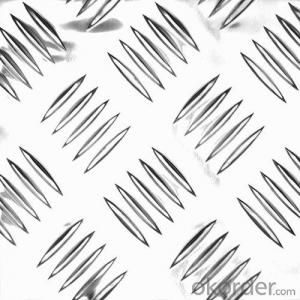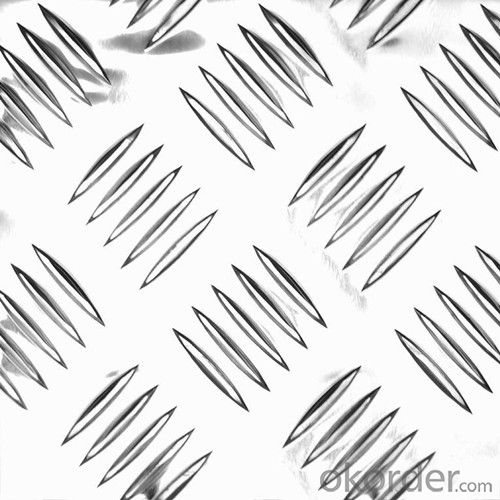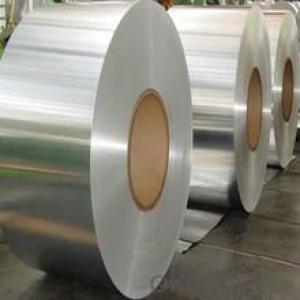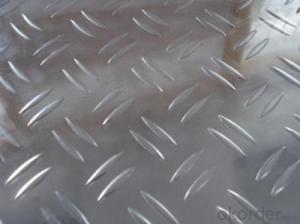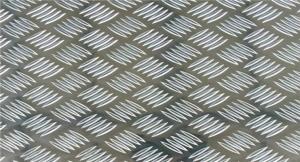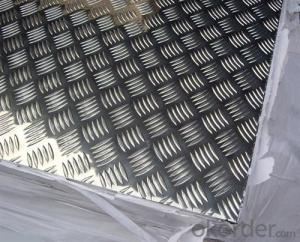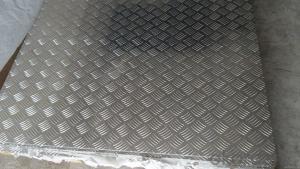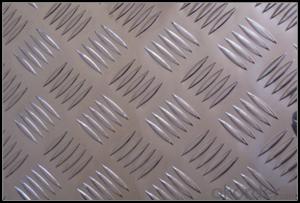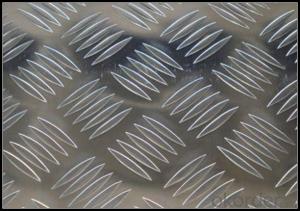040 Aluminum Coil - Aluminium Checkered Sheet with Five Bars
- Loading Port:
- China Main Port
- Payment Terms:
- TT OR LC
- Min Order Qty:
- -
- Supply Capability:
- -
OKorder Service Pledge
OKorder Financial Service
You Might Also Like
Product Description:
1. Specifications of Aluminum Checkered Sheet
| MAIN SPECIFICATION OF ALUMINUM CHECKERED SHEET | |
| Alloy | AA1XXX (AA1050, AA1060, AA1070, AA1100 etc.) |
| AA3XXX (AA3003, AA3004, AA3005, AA3105 etc.) | |
| AA5XXX(AA5052) | |
| Temper | H14,H18,H24, H26, H32 |
| Thickness | 0.2mm-100mm |
| Width | 30mm-1700mm |
| Standard | GB/T 3880-2006 |
| Special specification is available on customer's requirement | |
2. Usage/Applications of Aluminum Checkered Sheet
The embossed aluminum sheet are widely used for decorative purposes in construction, packing and appliance. It is also very commonly used for anti-splippery purposes in vehicles and public places.
3. Packing & Delivery of Aluminum Checkered Sheet
Packaging: Seaworth package
Shipment: The goods will be delivered in not more than 40 days after getting the buyer's payment.
- Q: What are the tensile strength properties of aluminum coils?
- The tensile strength properties of aluminum coils are known to be quite high. Aluminum, as a material, possesses excellent strength-to-weight ratio, which makes it suitable for various applications that require strength coupled with lightweight properties. The specific tensile strength of aluminum coils can vary depending on the alloy and temper used. Generally, aluminum coils have a tensile strength ranging from 110-310 MPa (megapascals), or approximately 16,000-45,000 psi (pounds per square inch). These values indicate the maximum amount of tensile stress that the aluminum coil can withstand before it breaks or deforms permanently. It is important to note that the tensile strength can be further enhanced by heat treatment processes such as cold rolling or annealing. Overall, aluminum coils are recognized for their impressive tensile strength properties, which contribute to their wide usage in industries like aerospace, automotive, construction, and manufacturing.
- Q: How are aluminum coils used in the production of power transmission lines?
- Aluminum coils are used extensively in the production of power transmission lines due to their unique properties and benefits. These coils are typically made from high-quality aluminum alloys that offer excellent conductivity, strength, and corrosion resistance. One key application of aluminum coils in power transmission lines is in the manufacturing of overhead conductors. These conductors are used to transmit electrical energy from power plants to substations and distribution networks. Aluminum coils are used to create the conductive core of these overhead conductors, as aluminum has a much lower resistance compared to other metals like copper. This low resistance allows for efficient transmission of electricity over long distances, minimizing energy loss and improving overall system performance. Moreover, aluminum coils are lightweight compared to copper coils, making them easier to handle and install. This characteristic significantly reduces the costs associated with transportation, installation, and maintenance of power transmission lines. As a result, aluminum coils have become the preferred choice for overhead conductors in power transmission systems worldwide. Furthermore, the corrosion resistance of aluminum coils ensures long-term durability and reliability of power transmission lines. Aluminum naturally develops a protective oxide layer that prevents further corrosion, even in harsh environmental conditions. This corrosion resistance extends the lifespan of the transmission lines, reducing the need for frequent repairs or replacements. In summary, aluminum coils play a crucial role in the production of power transmission lines. They enable efficient electricity transmission over long distances, reduce costs associated with installation and maintenance, and provide long-lasting corrosion resistance. With these advantages, aluminum coils have become a widely adopted solution in the power industry to enhance the performance and reliability of power transmission systems.
- Q: How do aluminum coils compare to fiberglass coils in terms of weight?
- Compared to fiberglass coils, aluminum coils are generally lighter in weight. Aluminum is renowned for its lightweight properties, making it an excellent choice for various applications, including coil manufacturing. On the contrary, fiberglass tends to be denser and heavier than aluminum. This disparity in weight offers several advantages when it comes to installation and transportation. The lighter aluminum coils are easier to handle, necessitate less effort for installation, and can be more cost-effective for shipping and logistics. Moreover, the reduced weight of aluminum coils contributes to overall energy efficiency in HVAC systems, as it requires less power to circulate air through the coils. Nevertheless, it is important to note that the weight comparison between aluminum and fiberglass coils may vary based on the specific design and thickness of the materials utilized.
- Q: How are aluminum coils tested for quality?
- To ensure compliance with the necessary standards, a variety of methods are employed to test the quality of aluminum coils. Trained personnel conduct visual inspections to identify any visible defects, such as scratches, dents, or surface imperfections. Likewise, dimensional inspections are carried out, utilizing precision instruments to measure the thickness, width, and length of the coils. This guarantees that the coils are manufactured within the specified tolerances. Furthermore, mechanical testing is performed to evaluate the strength and durability of the aluminum coils. Tensile and yield strength tests measure the maximum load a coil can endure without breaking or deforming, while bend tests assess flexibility and resistance to cracking. Moreover, chemical composition analysis is conducted to verify the purity and consistency of the aluminum material. Spectroscopy techniques, such as atomic absorption or emission spectroscopy, are commonly employed to determine the exact elemental composition of the coils. Coating tests are also conducted to assess the quality of any protective or decorative coatings applied to the aluminum coils. These tests include adhesion testing, corrosion resistance testing, and evaluation of color consistency. In addition to these conventional methods, advanced non-destructive testing techniques are utilized to detect any internal flaws or defects in the coils. Ultrasonic testing, eddy current testing, and X-ray inspection are employed to identify hidden defects without causing damage to the material. Ultimately, a combination of visual, dimensional, mechanical, chemical, and non-destructive tests ensures that aluminum coils meet the necessary quality standards before being utilized in various industries, such as construction, automotive, or electronics.
- Q: Can aluminum coils be bent or shaped?
- Indeed, aluminum coils possess the capability of being bent and shaped. Aluminum, as a remarkably malleable and ductile metal, can undergo manipulation and take on diverse forms effortlessly, without experiencing any fractures or cracks. The pliability of aluminum grants it the capacity to be bent, rolled, or molded into coils, solidifying its prominence in a wide array of applications, including the production of air conditioning units, automotive components, and packaging materials. The flexibility and shape-altering potential of aluminum coils render them exceptionally versatile and adaptable to meet specific design specifications, facilitating efficient and precise customization across a multitude of industries.
- Q: I did a activity series lab and on my data table, it shows that lead reacted more than aluminum did, but aluminum is more active than lead. So, why does it show that lead is more active when it really isn't? Is it human error?
- Aluminum is more active than lead. You should double check your activity data table. If you confirm that the table says that lead is more active than aluminum, the table is in error.
- Q: How do aluminum coils compare to copper coils in terms of performance?
- Aluminum coils generally have lower thermal conductivity compared to copper coils, which can affect their performance in terms of heat transfer efficiency. Copper coils are more efficient at transferring heat, making them more effective in cooling and heating applications. However, aluminum coils are lighter and less expensive, which can make them a suitable choice for certain applications with budget constraints or weight limitations. Ultimately, the choice between aluminum and copper coils depends on the specific requirements and priorities of the system in which they are being used.
- Q: does anyone know any ANTI-PERSPIRANTS that don't have any harmful chemicals such as aluminum chloride? I need something that makes you not sweat but I don't want bad chemicals in it!
- I have thoroughly researched this, as I have been wanting the same thing and was going to post this exact question myself. After A LOT of research, I have learned that aluminum and all aluminum based chemicals in antiperspirants are what keeps us from sweating. Therefore, they all have it, it is just a matter of what percentage. I found a posting by Dt. Stephen Z. Fadem, MD, FACP. He is a member of the AAKP Medical Advisory Board. He claims the the FDA came to a conclusion that aluminum is safe when used according to the directions. I have my doubts on this. The American Cancer Association found inconclusive evidence that the aluminum in antiperspirants is related to breast cancer. I am frustrated by this as well as I need antiperspirants too. However, I learned that if you switch to just a deodorant, your armpits still sweat, (as this is a natural way for your body to get rid of toxins, but gross), but not as much. I have also learned that if you don't allow your body to get rid of the toxins in this manner, some toxins are stored in a gland near your breasts and this one of the ways that many people believe you get breast cancer. There are several other places that your body sweats out toxins as well, including behind your knees. Sorry I couldn't be more help, but unfortunately, there is no such thing.
- Q: Is it possible to use aluminum coils in the creation of toys or games for children?
- <p>Yes, aluminum coils can be used to make toys or games for children, but safety considerations must be taken into account. Aluminum is a lightweight, durable, and non-toxic material, making it suitable for various applications, including children's toys. However, it's crucial to ensure that any aluminum used in toys is properly treated to prevent sharp edges or small parts that could pose a choking hazard. Additionally, the toys or games should be designed and manufactured to meet safety standards and regulations to protect children from potential harm.</p>
- Q: What are the different finishes available for aluminum coils?
- Aluminum coils offer a variety of finishes, each with its own unique properties and appearance. 1. The most basic and commonly used finish for aluminum coils is the mill finish. It showcases the natural appearance of aluminum without any additional treatment or coating. While it provides a smooth and shiny surface, it is not as resistant to corrosion as other finishes. 2. Anodized finishes, on the other hand, enhance the corrosion resistance and durability of aluminum through an electrochemical process. This creates a thick protective layer on the surface of the coil, making it highly resistant to weathering, scratches, and fading. Anodized finishes are available in different colors and can be customized to meet specific design requirements. 3. To achieve specific colors, textures, and levels of durability, aluminum coils can be painted with various types of coatings. These coatings are applied using a coil coating process, ensuring even distribution and curing onto the surface of the aluminum. Painted finishes offer excellent color retention and weather resistance, and can be tailored to suit individual project needs. 4. For a textured appearance, the surface of the aluminum coil can be mechanically brushed using abrasive materials. This creates a brushed finish, which not only provides a unique aesthetic appeal but also helps hide scratches and blemishes. Brushed finishes are commonly used in architectural applications like interior design, signage, and furniture. 5. Embossing involves imprinting patterns or designs onto the surface of the aluminum coil, resulting in an embossed finish. This adds texture and visual interest to the material, making it suitable for decorative purposes. Embossed finishes can mimic various textures, such as wood grain or stucco, and are widely used in building facades, roofing, and signage. 6. Laminating involves bonding a layer of protective film or sheet onto the surface of the aluminum coil. This laminated finish provides additional protection against scratches, stains, and UV rays. It is commonly used in applications that require high durability, such as transportation, appliances, and electronic enclosures. Ultimately, the choice of finish for aluminum coils depends on specific project requirements, including aesthetics, durability, and environmental factors.
Send your message to us
040 Aluminum Coil - Aluminium Checkered Sheet with Five Bars
- Loading Port:
- China Main Port
- Payment Terms:
- TT OR LC
- Min Order Qty:
- -
- Supply Capability:
- -
OKorder Service Pledge
OKorder Financial Service
Similar products
Hot products
Hot Searches
Related keywords
